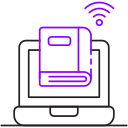Digital literacy has become a foundational skill in today’s interconnected world, shaping how individuals learn, communicate, and collaborate. As technology continuously transforms both educational environments and workplaces, the ability to effectively navigate digital tools is crucial for success. This page explores the importance of digital literacy, its integration in educational settings, its critical role in professional careers, and effective approaches to developing these essential competencies.
Navigating the Digital World
The digital landscape has changed the way we access and process information, highlighting the need for strong digital literacy skills. Today’s students and professionals are confronted with an overwhelming amount of information online, making it essential to distinguish between credible sources and misinformation. Being digitally literate means having the competence to use technology purposefully—whether it’s for research, communication, or collaborative projects. This skill ensures individuals can confidently interact with evolving digital platforms and tools, leading to more informed decisions in both their personal and professional lives.
Empowering Lifelong Learning
Digital literacy empowers individuals to become lifelong learners, embracing the constant changes that technology brings. With the rapid introduction of new devices, applications, and online resources, the ability to adapt and learn continuously has become imperative. Digital literacy provides a foundation for self-directed learning, where individuals seek out and assimilate new knowledge independently. This adaptability not only enhances personal growth but also increases employability and competitiveness in fast-paced industries.
Addressing Equity and Inclusion
Promoting digital literacy can help mitigate inequities in both education and the workplace by ensuring everyone has access to the skills and knowledge necessary for participation in the digital age. Not everyone comes from a background with equal access to technology or digital training. Schools and organizations that prioritize digital literacy create more inclusive environments by leveling the playing field for all learners and employees. This commitment to equity leads to more diverse ideas, perspectives, and opportunities for success across different communities.
Bringing digital literacy into the classroom revolutionizes traditional teaching methods and expands the possibilities for learning. Interactive digital platforms, educational apps, and online collaboration tools empower teachers to design engaging and personalized instruction that meets diverse student needs. As students become proficient with these tools, they gain not only the ability to use technology, but also the skills to think critically, solve complex problems, and collaborate with peers worldwide. This transformative approach equips learners with competencies that extend well beyond academic achievement.

A critical component of digital literacy in education is cultivating responsible digital citizens. Beyond simply knowing how to use technology, students must learn to navigate ethical issues such as cyberbullying, privacy, and digital footprint management. Educators play a pivotal role by embedding lessons on safe, respectful, and ethical online behavior into their curricula. By doing so, schools help students understand the impact of their digital actions and the importance of maintaining a positive presence online, which is essential in both academic and future professional settings.

Digital literacy opens doors to new forms of student engagement, making learning more interactive and meaningful. Gamification, multimedia projects, and real-time communication platforms provide students with hands-on opportunities to apply their digital skills in innovative ways. These engaging experiences increase motivation, participation, and retention of knowledge. By integrating technology purposefully, educators can foster curiosity and creativity while preparing students for the realities of a technology-driven world.
Adapting to Evolving Job Roles
The modern workplace is characterized by rapid technological advancements, which continually redefine job roles and required skills. Digital literacy enables employees to adapt quickly to new systems, platforms, and tools, ensuring they remain relevant in their fields. As automation and artificial intelligence reshape industries, the ability to learn and apply new digital solutions becomes vital for career advancement and job security. Cultivating digital literacy is an ongoing process that helps workers navigate the complexities of digital transformation.
Collaborating in Virtual Environments
Remote work and virtual collaboration have become integral components of many organizations’ operations. Digital literacy is essential for effective participation in virtual teams, where communication often occurs through video calls, messaging apps, and cloud-based platforms. Mastery of these tools facilitates seamless collaboration, allowing team members to share ideas, manage projects, and solve problems from anywhere in the world. Skilled digital communicators contribute to organizational success by driving productive interactions and leveraging the full potential of digital workspaces.
Driving Productivity and Innovation
Organizations that prioritize digital literacy among their workforce position themselves for higher productivity and sustained innovation. When employees are comfortable experimenting with new technologies, they can identify more efficient processes and creative solutions to complex challenges. Digital literacy fosters a culture of continuous improvement, where innovation is not limited to the IT department but becomes a shared responsibility. Investing in employees’ digital competencies is a strategic move that can lead to greater agility, market responsiveness, and long-term competitive advantage.
